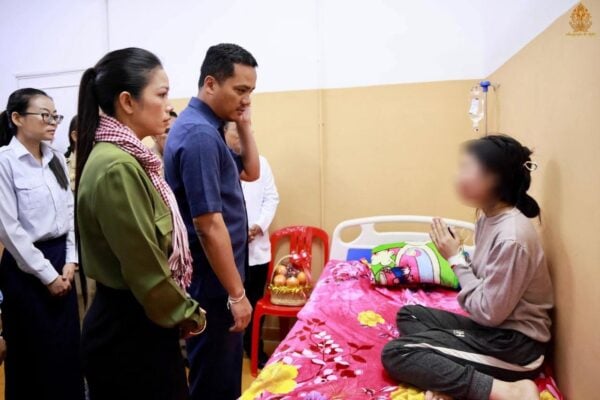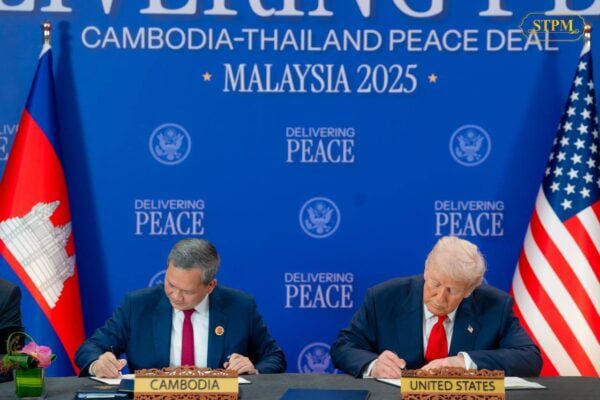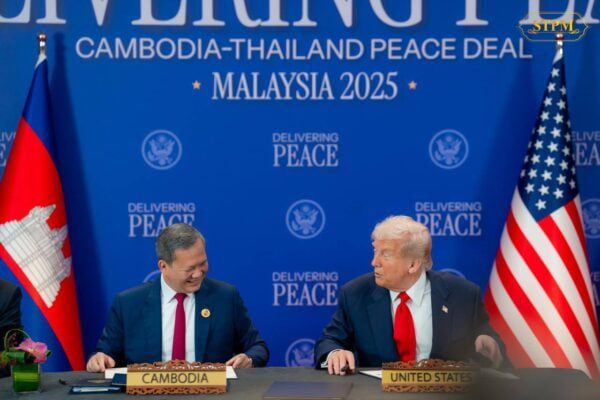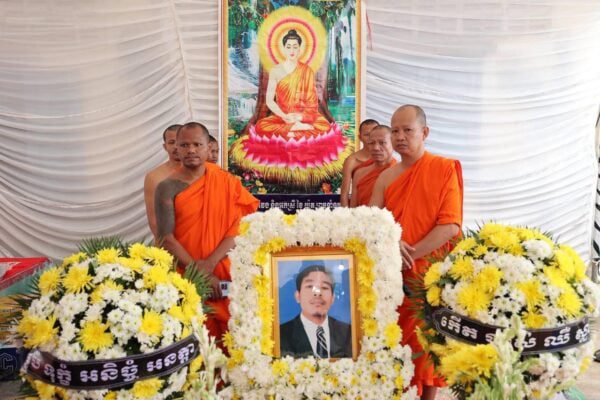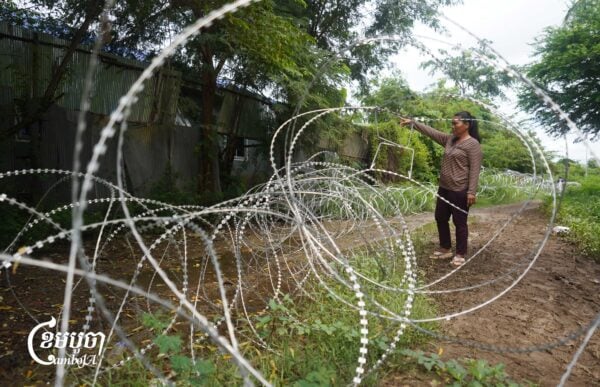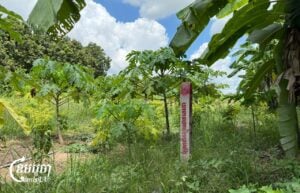The reciprocal tariff on all Cambodian goods by the US was revised down to 36 percent, from an initial 49 percent, effective August 1, according to an official letter from US President Donald Trump to Prime Minister Hun Manet on July 7.
However, the new tariff line has drawn concerns from trade unions and analysts, noting the challenges Cambodia could face from manufacturing shifts.
In the letter, Trump warned that goods transhipped to evade a higher tariff will be subject to even higher tariffs, while adding that the 36% tax is “far less than what is needed to eliminate the trade deficit disparity with Cambodia”.
“If for any reason you decide to raise your tariffs, then whatever the number you choose to raise them, will be added onto the 36% that we charge,” Trump said in the letter.
The Trump administration laid out revised tariffs for products entering the US from Laos and Myanmar (40%), Thailand and Cambodia (36%), Serbia and Bangladesh (35%), Indonesia (32%), and 25% tariff on goods from Malaysia, Tunisia, Japan, Korea and Kazakhstan.

Ministry spokespersons, including Commerce Ministry Secretary of State Penn Sovicheat, and Council for the Development of Cambodia (CDC) Deputy Secretary General Sar Senera, who were part of the negotiations with the U.S. Trade Representative, declined to comment.
Led by the Council for the Development of Cambodia (CDC) and Commerce Ministry, the government held four rounds of negotiations with the U.S since May 2025 over the new reciprocal tariff, with further opportunities available for talks before it takes effect on August 1.
U.S Press Secretary Karoline Leavitt told the press on July 7 that the reviewed reciprocal tariff rate will be provided in correspondence to foreign leaders within the month, or deals will be made in those countries that “continue to negotiate”.
On April 2, U.S. Trump announced sweeping reciprocal tariffs on countries, including Cambodia, which was hit with a 49 percent tax rate — the highest tariff in Southeast Asia.
Stephen Higgins, managing partner of Phnom Penh-based Mekong Strategic Capital, shared positive and negative views on the U.S. decision to impose a 36% tariff on Cambodian exports.
He said compared to Thailand, the new rate for Cambodia was better than 49% announced on April 2, because despite Thailand’s “offer” of a 20-year liquefied natural gas import deal, large-scale acquisition of Boeing jets, their “tariff rate went from 36% to 36%”.
“Cambodia’s tariff is 16 points higher than Vietnam’s — and that matters. We will shift some manufacturing from here to there,” he said via email.
“We’re on par with Bangladesh and Indonesia, key players in the global garment game,” Higgins said.
He joked that it “looks like the US would not be sending friendship bracelets anytime soon — at least not for the next 3.5 years”.
He pointed out that the IMF estimated at the time of the April tariffs that Cambodia’s five-year cumulative gross domestic product (GDP) growth would be 10 percentage points lower than their earlier forecast.
“Even with the 49% tariffs, they were expecting a 24% growth over the next five years — among the highest globally. With these slightly lower tariffs, we think GDP would be a couple of percentage points higher over the five-year period,” he opined.
On the labor side, Higgins said 360,000 Cambodian manufacturing jobs which depend on US demand, an estimate by the World Bank, will now be at risk.
“With similar tariffs on other exporters [except Vietnam] and the chance to redirect trade, actual job losses could be under 100,000 [which is] still painful, but not catastrophic,” he said.
According to the General Department of Customs and Excise, the U.S. remained Cambodia’s top export destination, with exports from January to May 2025 reaching $4.35 billion — a 27% increase compared to the same period in 2024. For 2024, total exports stood close to $10 billion.

Cambodian Alliance of Trade Unions (CATU) president Yang Sophorn, voiced concern over the high reciprocal tariff rates, noting that some investments will shift to Vietnam, which faces only a 20% tariff — significantly lower than Cambodia’s.
“The current impact we’re seeing is that, if there is no reduction in the reciprocal tariff, some companies may suspend operations or lay off workers,” she said.
In his Facebook page, American Chamber of Commerce in Cambodia president Casey Barnett posted that some factories are “now exploring outside beyond Asia”, including countries like Egypt, which offer low labor costs and a more favorable U.S. tariff rate of just 10%.
“Cambodia is behind Vietnam, which has a 20% rate. Vietnam has granted the U.S. duty-free access to the Vietnamese market,” he wrote.
He commended Cambodia’s highest tariff reduction among the 14 countries, thanks to its active engagement with the U.S. trade representatives. As a result, it is more competitive with key rivals, such as Bangladesh and Indonesia, he said.
In 2024, Cambodia‘s exports of garments, textiles, footwear, and travel goods were worth $13.92 billion, marking a 23 percent increase compared to the previous year. As of 2024, some 1,555 factories and enterprises were operating nationwide, employing nearly one million workers.
Textile, Apparel, Footwear and Travel Goods Association in Cambodia (TAFTAC) deputy secretary-general Kaing Monika said there is “still time” for Cambodia to negotiate with the U.S.
“There are three weeks left to reach deals that could reduce these rates, and adjustments remain possible even after August 1,” he said, adding that as of now, the “threat” is that this rate will take effect on August 1, leading to prolonged uncertainty.
Meanwhile, Labor Minister Heng Sour, along with ministry spokesperson Sun Mesa, expressed optimism that major companies will not withdraw their investments from Cambodia despite the high costs associated with expansion and installation procedures.
“These tariffs do not mean buyers will stop purchasing goods from Cambodia. Even in Vietnam, tariffs range from 20% to 40%, and yet 40% of products are still assembled there,” Sun Mesa said.
He cited a 40% tariff being applied to goods that are merely transshipped through Vietnam, meaning goods made elsewhere but passing through Vietnam.
“There is currently no sign of mass factory relocation from Cambodia. Major companies rarely move operations permanently because relocating factories is extremely costly,” Mesa said.
He added that investing in another country, especially in terms of land acquisition, construction, and infrastructure can take several years to complete.
He noted that the U.S. is not the only market for Cambodia. It can continue to export to other major markets, including the European Union, the United Kingdom, Japan, China, Canada, and Australia.
In the first half of 2025, the CDC approved 373 investment projects with a total value of $5.8 billion. It is expected to create approximately 255,000 jobs.
China remains the top investor, accounting for 56.23% of total investment.



